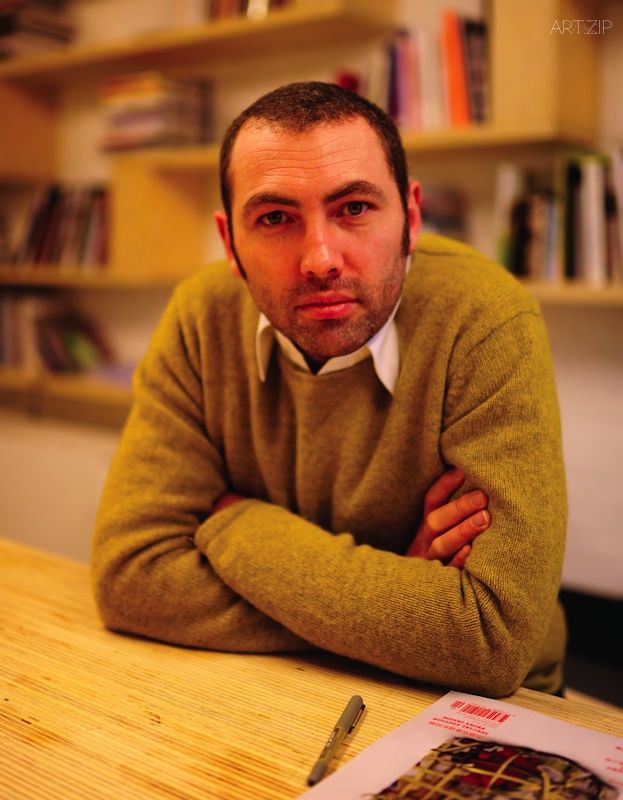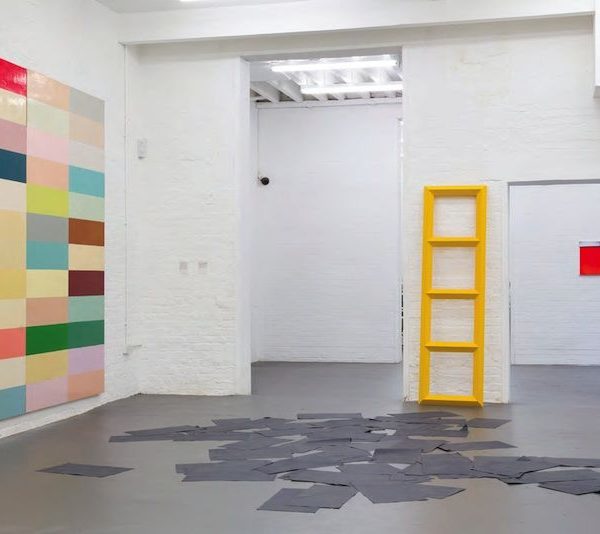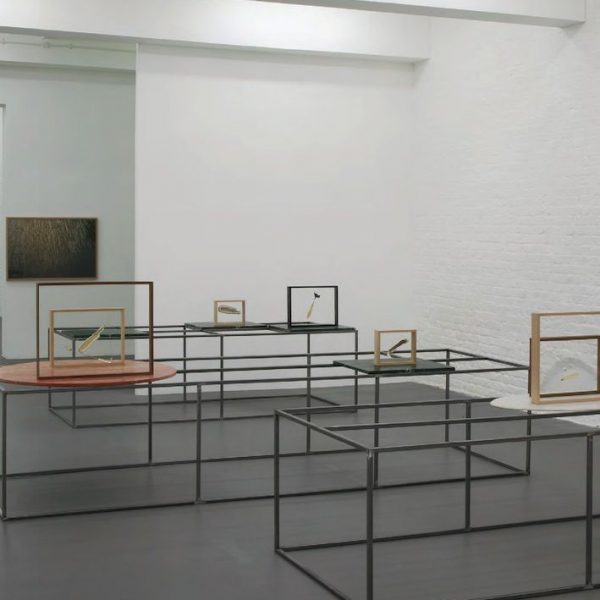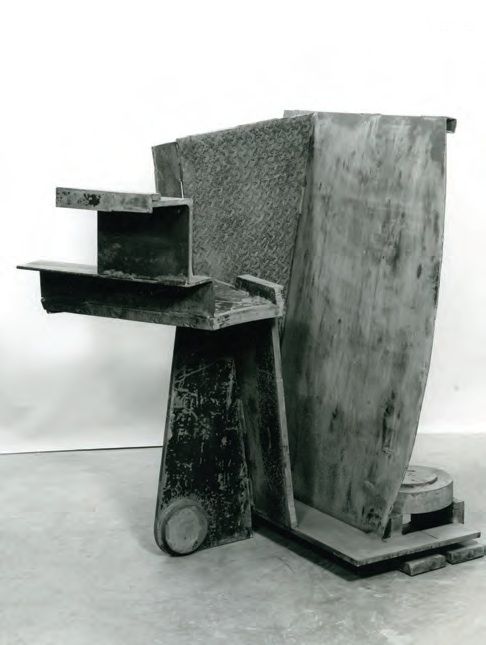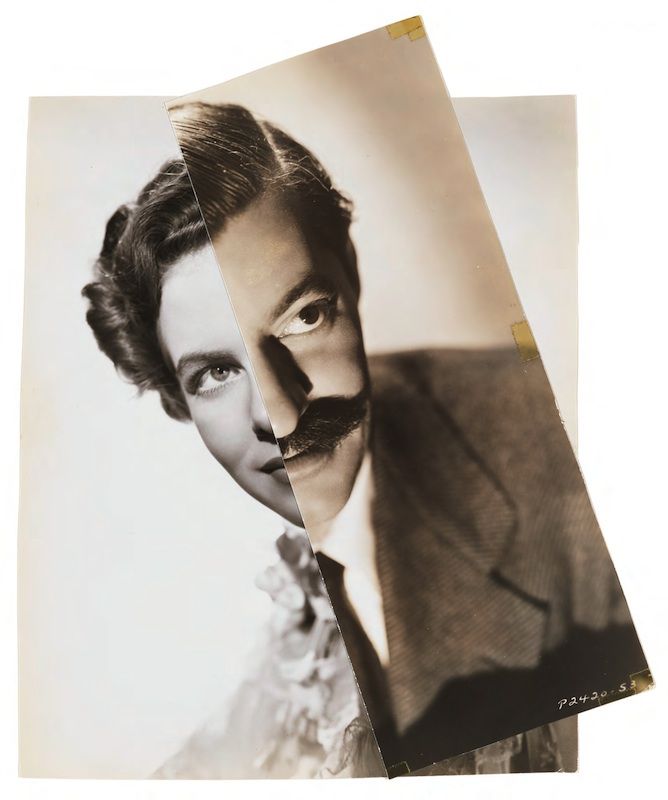
.
.
David Roberts is a commercial property developer and is considered as one of the UK’s most important art collectors. In 2008, Roberts launched the first part of the David Roberts Arts Foundation to benefit young curators and artists, at 111 Great Titchfield Street in London. He had realized during the construction period that the space would be too small, therefore he acquired a ware house in Camden, which transformed into a gallery space and head quarters for his philanthropic Foundation. AR T.ZIP invites the director Vincent Honoré to give us the idea of the DRAF .
大衛·羅伯茨是一位商業地產開發商,同時也被認為是英國最為重要的藝術收藏家。在2008年,他在倫敦市中心的大蒂奇菲爾德大街建立了大衛·羅伯茨藝術基金會(DRAF ),基金會旨在幫助年輕的策展人和藝術家。後來,在基金會場地建設施工期間,他意識到基金會的畫廊空間太小,因此他將倫敦卡姆登區的一座倉庫改造為新的基金會總部和畫廊。今天我們有幸採訪到了基金會的總監文森特·托納(Vincent Honoré)。
.
—————————————————– .
.
A: Could you give us a brief introduction of DRAF ?
V: DRAF is a private foundation: a public space with a public mission, but privately funded. Our core aims are education and promoting contemporary art, and we achieve these aims through 3 main activities: collection, production and research. DRAF is a research structure, a resource where curators, critics, scholars, and the audience, all together we try to understand what is contemporary art and what is contemporary culture.
A: 你能夠簡要介紹一下DRAF 嗎?
V:DRAF 是一個私人基金會:一個由私人資助,但具有公共使命的公共空間。我們的核心目標是教育和推廣當代藝術,主要通過收藏、創作和研究這三種方式來實現。DRAF 的結構是以研究為基礎的,一個讓策展人、評論家、學者和觀眾能夠共同學習當代藝術和當代文化的場所。
.
A: How would you distinguish DRAF from other foundations?
V: One of the main features of DRAF is that it promotes curators and reflects on curators’ methods. Another important feature is how we enliven the foundation with various performances, talks and even the exhibitions themselves which sometimes keep changing. We invite the audience to be the co-producers of the exhibitions. As a matter of fact, we don’t speak to a mass, we speak to visitors, we speak to informed individuals, and we speak to actors of the foundation: this is I guess something our visitors enjoy a lot.
A:DRAF 與其他藝術組織有哪些不同之處?
V:最主要的區別在於DRAF 會推廣策展人及其策展方式。另一個重要的特點是我們會策劃各式各樣的表演和講座,甚至展覽也時常變換,從而使基金會變得有聲有色。我們邀請觀者也成為展覽製作人的一部分。事實上,我們面對的不是大眾,而是前來參觀的人,圈內人士,以及基金會的行動者。我認為這是我們的觀眾感到樂在其中的原因。
.
.
A: Would you like to refer any specific programmes that deliver the notion of the space?
V: I would hope that the whole project all together gives an idea of our ethics. But should I name one programme, I would possibly choose the Curators’ Series, a series of exhibitions that we commission international curators. So far we have had six international curators: we started with Cylena Simonds, a North
American curator, then we invited Raimundas Malasauskas, a Lithuanian curator, who recently worked as one of the curators for Documenta, followed by Mihnea Mircan, a Romanian curator, who is now the director of Extra City, a contemporary art centre in Antwerp. Then Mathieu Copeland, who is an English curator based in London and Paris, who is now the guest curator at the Jeu de Paume in Paris. The next curators were a collective: Christ Sharp and Simone Menegoi, an American curator and an Italian curator. This year, we will work with Pablo Leon de la Barra, a Mexican curator based in London. So through this series, we try to show different curatorial methodologies , we want to articulate an exhibition as not necessarily a number of objects in the room, on the floor and on the wall, but as something else. In this series, I am trying to show different styles, different intellectual understandings of the world and of contemporary art. I think it is very important DRAF doesn’t become a tomb, or a monument, a monument of glory to the collector, David Roberts, or the glory of the director, myself. We can be alive by inviting many people to produce things together and try to learn, constantly learn. With Pablo Leon de la Barra for instance, we will research the Latin American scene in London in the 60s and 70s. Maybe another program I could speak about is called “the Study” in which we isolate an artwork in a gallery. And we study it, from its materials to its concept. I am really keen on this series. It is an in-depth understanding of what is an artwork.
A:你能夠列舉一些體現這個空間理念的具體項目嗎?
V:我希望這裡所有的項目能夠整體呈現我們的創想。但如果要點名某個項目,我應該會選擇“Curators’ Series( 策展人系列 )”這個項目,是我們委托國際策展人舉辦的一系列展覽。到目前為止,我們已與六位國際策展人合作。我們首先邀請的是北美策展人塞琳那·西蒙斯(Cylena Simonds),接著是文獻展(Documenta)策展人之一的、來自立陶宛的雷蒙達斯·馬拉索斯卡斯(Raimundas Malasauskas),然後是來自羅馬尼亞,現任安特衛普當代藝術中心館長的米尼爾·莫卡( Mihnea Mircan )。還有駐倫敦和巴黎的英國策展人馬西歐·寇佩蘭德(Mathieu Copeland),現任巴黎國立網球場現代美術館( Jeu de Paume )的客席策展人,以及分別來自美國和意大利的策展雙星克利斯特·夏普( Christ Sharp )和西蒙·蒙那高(Simone Menegoi)。今年,我們將與來自巴西、現駐倫敦的策展人帕巴羅·里昂·德·拉·巴拉( Pablo Leon de la Barra)合作。通過這一系列的合作,我們嘗試呈現出不同的策展方法論,希望闡明一個展覽不是作為一個空間裡、地面上和墻壁上的一些物品展示,而作為別的事物而展示。在這個系列項目裡,我嘗試為觀者展現他人對世界和當代藝術不同的領悟。最重要的一點是,我希望DRAF 不會成為一個陵墓,或一座紀念收藏家大衛·羅伯斯(David Roberts)的榮耀豐碑,也不是我本人的豐碑。我們會邀請不同的人合作來進行創作,並嘗試去學習,不斷地吸收新知識來使自己變得有活力。譬如與帕巴羅·里昂·德·拉·巴拉的合作,我們將會研究60年代和70年代倫敦的拉美文化景象。
另外一個項目“學習(the Study)”也值得一提。我們將一個藝術品單獨置於畫廊裡,然後對它進行學習研究,從材質上到觀念上的研究。我非常熱衷於這個系列的研究,這是一種深入了解什麼是藝術品的學習。
“
Museums are houses full of thoughts’, according to Marcel Proust,DRAF can be such a house, rich in sensibilities, styles, and voices.
馬塞爾•普魯斯特(Marcel Proust)曾經說過“博物館是滿載思想的穀倉”,DRAF也致力於成為這樣的一個地方,充滿豐富的情感,風格和不同的聲音。
———-
Every time an artwork is acquired the whole collection’s dynamic changes. In fact, the whole reacts to the parts, as each time a new acquisition is made, the entire collection expands with new possibilities of existence. This is an intrinsic quality of a collection: in order for it to be alive, it needs to always be activated and reconsidered; it is always in t he stage of ‘ becoming’.
每一件新藝術品的購入都會導致整個收藏的動態變化。事實上,在每一次新的部份被接納的時候,從整體上整個收藏拓展了它作為一個集合而存在的新的可能性。整個收藏體系是一個內在的有機體:為了保持鮮活的生命力,它總是要求不斷的刺激并不斷地反思以保持自身永遠處於“正在形成”的階段。
———-
Study is not an attempt to capture or seize but a methodology of encounter and the insistence on the provisional as both form and content within the process of research. It is an exercise in responding to the infinite demands of the work, not meant to bring forth any historical truth but rather to enter into dialogue with the work.
研究或者學習並不是試圖捕捉或者獲取某種知識,而是一種通過研究過程中不斷出現的、在內容與形式兩方面發生持續碰撞的方法論。在面對無盡可能性的作品時,它就成了一項訓練,它不代表能帶來任何歷史的真相,而是一個与藝術品發生對話的實踐。
”
A: So there isn’t a set mode for doing projects?
V: I don’t want to have any hierarchy between a 5 seconds performance, or 5-6 months long exhibition, I think everything is important. Everything should have the same importance to us.
A:所以你們沒有一個固定的模式做項目策劃?
V:我不希望在一個五秒的表演和一個長達五六個月的展覽之間作出任何輕重的評估,我認為無論哪個都是同等重要的。所有的項目對我們都有著同樣的重要性。
A: Do you do anything to promote young artists, curators etc.?
V: Not necessarily young, because I don’t base my research on generations. For instance, we recently worked with Bruce McLean, a historical artist here in the UK, and we work also with emerging artists, as talent doesn’t have any age. It doesn’t make sense to me actually. Having said so, when you come to the openings, when you come to our performances you realize our audiences are relatively young, the visitors come to participate with us, they co-produce a culture.
A:你們會推廣年輕的藝術家或策展人嗎?
V:不一定是年輕人,我們的研究領域沒有輩份之分。比如,我們最近才與英國的史學藝術家布魯斯·麥考林(Bruce McLean)合作,同時我們也與一些新晉的藝術家合作,才華並沒有年齡的限制。我認為按輩份區分是不合理的。但當你參加首映、參與我們的活動時也會發現,前來參加的觀眾都是相對年輕的群體,他們參與到我們的項目之中並與我們共同參與文化生產。
A: Is there anything you are doing to develop new audiences?
V: We are speaking a lot with universities. But maybe I should start with what we are not doing. At the moment, we don’t have any programmes for the children, because we don’t have expertise to do that. I think it has to be done by someone who knows perfectly well what he or she is doing. We don’t have a programme for small communities or groups, as we don’t focus on specific groups. However we are speaking to different universities in London, we do some music and dance as well, so we are bringing in different audiences . Of course we want to share our activities, but on the other hand we should not compromise them: I don’t want to be populist to increase numbers. One thing to add: because we are privately funded we don’t have to justify our audience. It is then not the audience that should demonstrate the artistic project in the foundation, that is a luxury, and we should really try to keep it as it is.
A:你有拓寬新觀眾群的計劃嗎?
V:我們正與許多大學聯系,或者我應該從我們未涉及的領域開始說起。現在我們沒有任何的兒童項目,因為目前還沒有這方面的專業人士,我認為這個任務必須由那些確實知道如何操作的專家來執行。我們也沒有與小群體、小組織相關的項目,因為我們沒有將目標鎖定在一些特定的群體。但是我們正在與倫敦的各個大學溝通,同時我們也會加入一些音樂和舞蹈的項
目來吸引更多不同的觀眾。我們當然希望與更多的人分享我們的活動,但我們並不希望為了增加觀眾的數目而作出妥協從而變得平民化。還有一點,我們是一個私人投資的基金會,我們不需要向任何機構交代我們的觀眾群。所以我們並不奢望由觀眾來闡明任何藝術項目,而應該保持原樣,任其自由發揮。
。
A: So we may say this is the key advantage of private foundations?
V: I think it’s a huge advantage of private foundations.
A:所以這是私人基金會的一個重要優勢嗎?
V:我認為這是個巨大的優勢。
。
A: Are there any regulations that restrict the operation of the foundation?
V: We are not commercial so we can not sell artworks. That’s one of the regulations. And then you have all the health and safety regulations. We also can’t be open all night, or have a big party downstairs (in the space). But apart from that, we are quite flexible.
A:你們需要被一些條例監控基金會的運作嗎?
V:我們不是商業機構所以不能做藝術品的買賣,這是其中的一個規則。然後就是一些健康與安全條列,我們不能通宵舉辦活動,或者在樓下的空間舉辦大型派對,除此之外,我們都比較靈活。
。
。
。
A: Are all annual reports accessible to audience?
V: Yes, legally we have to make this available. The Arts Council has funded us for the Curators’ Series. In this case we have to justify a lot of things, which of course is totally right. Such as number of people coming to see the exhibition, how we promoted the exhibition, where the money went for etc. These aspects were strictly controlled. OUR AC TIVITIES ARE controlled, ES PECIALLY THE FINANCIAL PAR T.
A:你們的年度報告是否對大眾開放?
V:是的,在法律上我們必須這麼做。藝術委員會(Arts Council)資助了我們的策展人系列,在這種情況下,我們必須交代許多事情,這確實是合情合理的。例如,有多少人前來觀展,我們如何推廣展覽,資金費用的去向,這些方面都是受嚴格的控管。所以我們舉辦的活動會受到監管,尤其是財務這一方面。
。
A: Do you have any future projects working with Chinese artists or curators?
V: I am shameful: I don’t think I’ve ever worked with Chinese artists or curators. We have a few Chinese artists represented in the collection though, such as Zhang Huan and a few others. But I never directly worked with Chinese art. Why is that? First, I would need to research and to understand if something like Chinese contemporary art exists or not. Maybe there is Canton, Shanghai, Beijing contemporary arts and certain kind of scenes but Chinese as one entity, I would need to discuss that and to research that.
Also, does the concept of “contemporary art” applied to the art currently being produced in China make sense? Because this concept of contemporary art is very western. With Chinese contemporary art, I also think I don’t have the expertise, I would be very prudent with that. It takes me a long time to understand an artist, to work on a project and then work with the artist. Actually I worked with a Chinese artist before, I worked with Chen Zhen before.
I must say I was very surprised when I visited Shanghai. I had a meeting with someone, who is working for a very important Chinese collector. I understood they are commissioning a building, a major building to dream for, but I found they had no idea what to do with that.
It may not be only Chinese: contemporary art often has to be big, it has to be spectacular . I think art doesn’t work like that. Art is a delayed action in many ways. If you build a contemporary art collection which is based solely on the spectacular, you run the risk of this just being a noise to be forgotten three months after you open your museum. So a collector needs to understand that his action is not in the now , his action is in the future.
A:在未來項目裡,你們打算與中國藝術家或策展人合作嗎?
V:很遺憾的是我們還沒有與中國藝術家或策展人合作的機會。但是我們的藏品中有中國藝術家,如張洹和其他幾位藝術家。但我們沒有直接從事與中國藝術相關的項目。主要原因是,首先,我需要考察和了解中國當代藝術是否存在。或許在中國,有廣東、上海、北京的當代藝術,和類似的文化景象的存在,但是以中國作為一個整體來看待的當代藝術,我需要探討
和研究這一方面。
此外,“當代藝術”這一概念應用於目前中國創造的藝術是否合理呢?因為這是個十分西化的藝術理念。對於中國當代藝術,我還沒有具備足夠的專業知識,所以我必須對此謹慎對待。我需要花一段很長的時間去了解一位藝術家,去進行相關的項目研究,然後與這個藝術家合作。其實,我曾與一位中國藝術家陳箴合作。
我必須說到上海的時候感到非常驚訝。當時我與一位人士開會,他為一個非常重要的中國收藏家工作。我發現他們希望資助建設一座夢寐以求的建築,但他們並不知道建以何用。
或許不僅僅只是中國人有這樣的問題:當代藝術必須是宏偉壯麗、驚為天人的。但我認為藝術不應該是這樣的。在許多方面上,藝術的影響是依靠時間的推延而彰顯的。如果單單出於表面雄偉壯觀這一目的,那創建一系列的當代藝術創作便要承擔風險,或許你所開設的博物館只是一時的響噪,三個月後便會被人們遺忘。所以收藏家必須明白他的一切行動不應該著眼於現在,而是展望未來。
。
A: Which artist from France would you recommend?
V: There are many actually , I can name a trilogy : Daniel Buren, he is extraordinarily important. The second one is Pierre Huyghe, from a different generation, he was born in 1962,. He will have a solo exhibition this year at the Pompidou Centre. The next one I would say Benoit Maire. Benoit Maire was born in 1978, and he’s using philosophical concepts and turning them into forms. Benoit works with films, prints, sculptures, and he does installation. We will have his solo exhibition here in March. Other artists I could name: Cyprien Gaillard just opened, two days ago, a solo exhibition at the MoMA .
Cyprien works with video and installation, very much related to the possibility of disaster and the idea of romanticism as well. Neil Beloufa is another artist. He works a lot with images on how they can be circulated and can be transmitted, and transformed and digested and re-transformed, transcribed.
A:你能給我們推薦幾位不錯的法國藝術家嗎?
V:實際上法國有許多很好的藝術家,在這裡我介紹三個吧:丹尼爾·布倫( Daniel Buren ),他是格外重要的一位藝術家。其次是成長在不同年代的皮埃爾·回約(Pierre Huyghe),出生於1962年,今年他將會在蓬皮杜藝術中心舉辦個展。另外一個是博奴瓦·邁爾( Benoit Maire ),出生於1978年,他會運用哲學的理念將其轉化為各種形態。博奴瓦的創作領域涉及電影,版畫和雕塑,同時他也做裝置藝術。我們從三月份開始就會有他的個展。還有其他很好藝術家,包括希普利安·蓋拉德(Cyprien Gaillard),剛在兩天前於紐約現代藝術博物館(MoMA )開辦他的個展。希普利安以短片和裝置的形式做創作,以災難的可能性和浪漫主義為相關主題。還有另外一位藝術家尼爾·梅洛法(Neil Beloufa),他著手於大量的圖片創作,研究如何將其傳閱,傳送,轉化,消化和重新改造,再轉錄。
。
A: Would you like to highlight any particularly remarkable pieces in the collection?
V: I was thinking about that all this morning. I was thinking about modern art and its relation to the concept of the masterpiece, and about conceptual art in relation to masterpiece. Modern art was all about the masterpiece, while conceptual art was originally against the idea of masterpiece. Referring to the collection, I try to think what are the masterpieces of this collection. Damien Hirst, ‘The Adoration’, which is an installation from 2007, in which for the first time he’s using gold; Hans Bellmer, a work from 1936, where he refers to
Marcel Duchamp. It’s quite extraordinary . I would say Louise Bourgeois’s sculpture from 2007. And many other works by Philip Guston, Cindy Sherman, Bruce McLean, Thomas Houseago, Martin Boyce, John Latham, and so on. Mark Manders’ sculpture is quite good also, I would say Kris Martin, the big sculpture we had downstairs, is a masterpiece. Matthew Day Jackson, ‘ The Map of London’, is one of the highlights of the collection.
A:你能推薦一些藏品系列中最為突出的作品嗎?
V:我整個早上都在思考,怎樣的作品才能算得上是“傑作”呢?因為現代主義藝術裡“傑作”的概念在當代藝術語境和概念之中是截然不同的,當代藝術從某種意義上來說是反對“現代主義”或者說是反對“傑作”這個概念的(我們應該說是一些重要作品)。所以從我們的藏品系列裡,我會挑達明安·赫斯特(Damien Hirst)的《崇拜(The Adoration)》,2007年創作的裝置藝術,這是他第一次用純金做的作品;漢斯·貝爾默( Hans Bellmer )一件1936年的作品, 是一件向馬歇爾·杜尚( Marcel Duchamp )致敬的重要作品。還有露易絲·布爾喬亞(Louise Bourgeois)2007年的雕塑作品,還有菲利普·古斯頓(Philip Guston)、辛迪·舍曼(Cindy Sherman)、布魯斯·麥克林(BruceMcLean)、托馬斯·毫斯戈( Thomas Houseago )、
馬丁·博艾斯( Martin Boyce )以及約翰·拉散姆(John L atham)等藝術家的作品。馬克·曼德斯(Mark Manders)的雕塑非常出色,我認為樓下畫廊裡的大型雕塑作品《克利斯·馬丁( Kris Martin )》是一個傑作, 馬修·德·傑克森(Matthew Day Jackson)的《倫敦地圖( The Map of London )》也是藏品裡的亮點之一。

